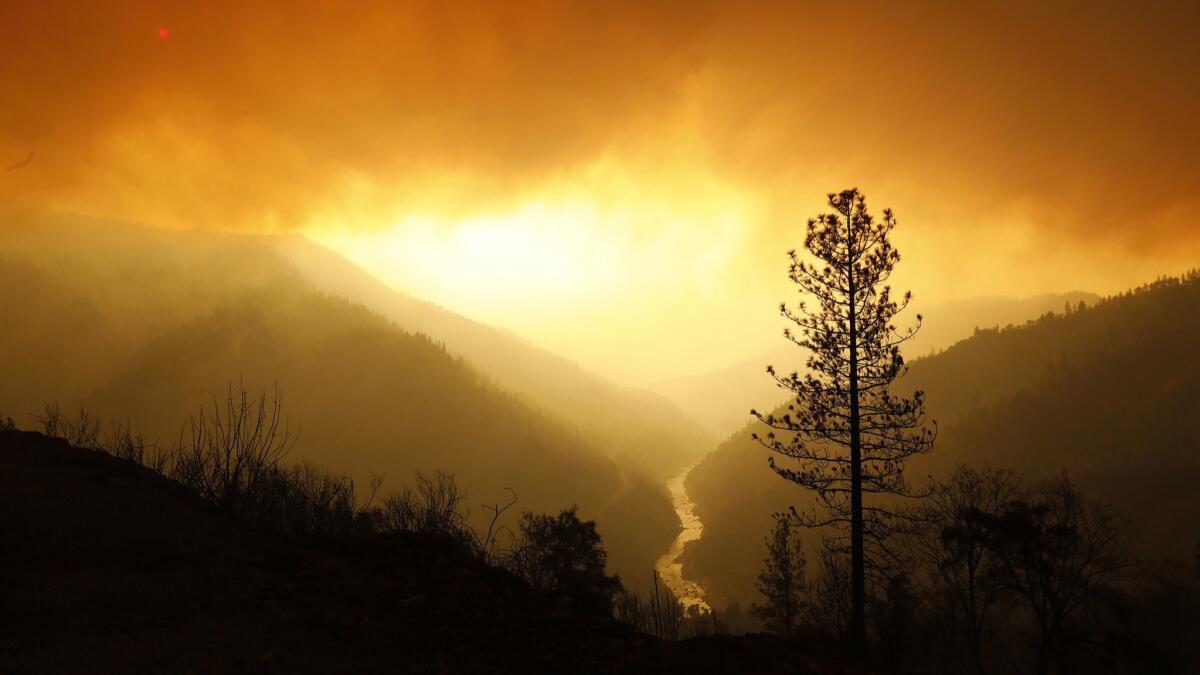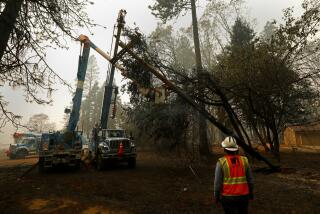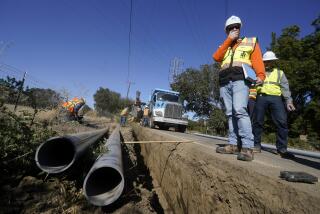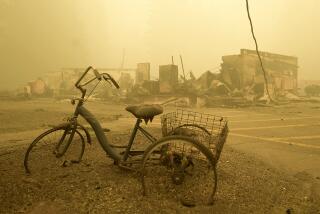PG&E and Edison stocks plummet as California wildfires burn

Stocks of California’s two largest utility owners, PG&E Corp. and Edison International, plummeted again Monday as investors feared that the deadly wildfires raging in the state could leave the utilities with massive liabilities.
It was the stocks’ worst drubbing since the California power crisis more than 15 years ago.
The shares plunged in the first minutes of trading — with PG&E dropping 37% and then being briefly halted — before they later pared their losses.
PG&E, the parent of Pacific Gas & Electric, tumbled 17.4% on the day to $32.98 a share. Edison International, which owns Southern California Edison, dropped 12.2% to $53.56 a share.
PG&E shares have dropped one-third in the two trading sessions since the Camp fire in Butte County broke out last week, wiping out more than $7 billion of PG&E’s total market value.
Edison International shares have dropped 24% in the last two sessions as the Hill and Woolsey fires spread in Ventura and Los Angeles counties.
They were the two utilities’ worst declines since power shortages triggered rolling blackouts across California in 2000-01, a crisis that led the Pacific Gas & Electric unit to file for bankruptcy protection in 2001.
Although the causes of the fires have yet to be determined, investors are worried that the utilities could face liabilities associated with the blazes. Investigators are looking at electrical equipment as one of several possible causes of the Camp fire, about 150 miles northeast of San Francisco.
A PG&E transmission line in the area went offline 15 minutes before the fire was first reported, and the company reported finding a damaged transmission tower near where investigators said the fire began.
The Camp fire’s death toll climbed to 29 on Sunday, with the whereabouts of 228 people still unknown, authorities said.
Camp fire’s death toll mounts in Paradise as the search for victims continues »
Southern California Edison, meanwhile, said a power outage occurred near the suspected starting point of the Woolsey fire and that a sensor detected a disturbance in its equipment two minutes before the blaze was reported. Two people have died in that fire.
Number of structures destroyed in Woolsey fire doubles; new fire closes 118 Freeway »
Together, the wildfires have destroyed more than 6,700 structures and could cost the state, insurers and homeowners at least $19 billion in damages, according to an estimate by Enki Research.
“We’re not going to speculate or comment on what factors may or may not be impacting the market,” said Paul Doherty, spokesman for San Francisco-based PG&E. “Right now, our entire company is focused on supporting first responders and assisting our customers and communities impacted by the Camp fire.”
Edison did not immediately respond to requests for comment.
Southern California Edison said last month that its electrical equipment likely sparked at least one starting point in the massive Thomas fire that ravaged Ventura and Santa Barbara counties late last year. That fire also killed two people.
Susquehanna Financial Group estimates that PG&E could face as much as $5 billion in liabilities from the Camp fire. That would come on top of deadly fires in California last year that could cost the utility as much as $17.3 billion, according to a JPMorgan Chase & Co. estimate.
Further clouding the issue of whether, or how much, the utilities might be liable for damages is a new state law that takes effect in January.
Among Senate Bill 901’s requirements is that state regulators determine whether a utility acted responsibly before the outbreak of any fire linked to the company’s equipment or operations. If they find that the utility did act responsibly, it could bear less liability — creating a chance for the utility to pay only a portion of the damages that the current rules might otherwise require.
But lawmakers, who haggled over the fine points of SB 901 for most of the summer, left what now appears to be a gaping hole in the new wildfire plans. The law gives PG&E, in particular, a mechanism to borrow money for costs related to the 2017 fires and for minimizing the financial impacts for incidents beginning in 2019. But it leaves the existing system in place for any fires that break out this year.
As a result, the long-standing rules of “inverse condemnation” — where a utility can be forced to pay millions of dollars without a strict finding of bad behavior — remain in place.
That bodes poorly for PG&E, according to Moody’s Investors Service. The credit-rating firm noted Monday that the “legislation does not address recovery for any potential liabilities related to wildfires that occur in 2018.”
As a result, “the magnitude of the [Camp] fire’s destruction leads us to believe the potential liabilities could be material for PG&E,” Moody’s said.
Peltz is a Los Angeles Times staff writer. Ryan writes for Bloomberg. Times staff writer John Myers in Sacramento also contributed to this report.
UPDATES:
1:50 p.m.: This article was updated with closing stock prices, details about a new state law covering utilities’ exposure to fire damages and a related report from Moody’s.
11:15 a.m.: This article was updated throughout with Los Angeles Times staff reporting.
This article was originally published at 9:15 a.m.
More to Read
Inside the business of entertainment
The Wide Shot brings you news, analysis and insights on everything from streaming wars to production — and what it all means for the future.
You may occasionally receive promotional content from the Los Angeles Times.











